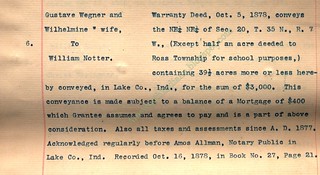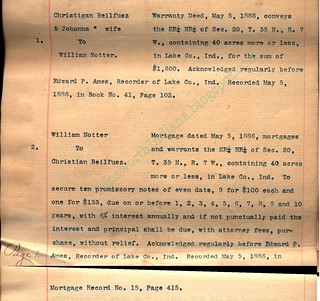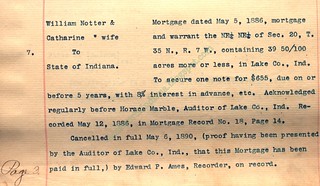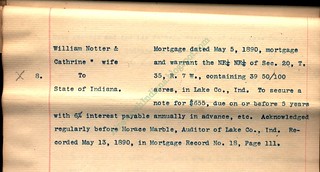
(Click on images to enlarge)
Title abstract images courtesy of the Eldon Harms family.
… who assumed the remainder of the mortgage on the land. By 1880 they had paid it off:

In 1886 the Notters bought the southern 40 acres of the future Harms farm from Christian and Johanna Beilfuss.

The day of that sale, the Notters borrowed money from the State of Indiana, mortgaging their northern 40 again.

In 1890 and 1894, the Notters again borrowed money from the state, securing the debt with mortgages on both the northern and southern halves of their farm. I have no idea what was going on here.


They did pay off their debt to the Beilfusses in 1893.

William Notter was a native of Canada, born circa 1837. He came to the U.S. probably in the early 1860s, since he married an Illinois-born woman, Catharine Golden, before 1864.[2] In the 1870 Census, the Notter[3] family was recorded in Chicago, with three sons: William (born circa 1864), Thomas (1867), and Edward (1869).
As we've seen, in 1878 they bought their first 40 acres and presumably relocated to Ross Township, where the 1880 Census records them. Their eldest son, William, was not accounted for in that census; possibly he had died; it's also possible he left home at 15 or 16 years of age. The Notter children accounted for in 1880 were Thomas and Edward, and a daughter, Fannie, born circa 1875.
In 1891, William and Catharine leased their 79.5 acres in 1891 to Christ Springman:

Since two families had once occupied those 80 acres, perhaps there was a spare house for the Notters to live in while Christ Springman ran the dairy farm. But at some point William bought another 13 acres on the northeast corner of the intersection of Randolph and 73rd, per the 1908 Plat Map.
Sometime before 1900, Catharine died — when and where, I don't know. I can't find any record of the death, or a grave, either here in Ross Township, or in Illinois. The last mention we have of her is the 1894 reference in the title abstract.[4] The 1900 Census shows William, a widower, living alone in Ross Township, farming his own land (probably the 13 acres). The children had grown up and left home.
The "General News Items" of the Hobart Gazette of February 8, 1901, carried an item noting that William Notter "who lives about one-half mile west of Deep River" had sold all his goods and was planning to move to Chicago. But it wasn't until the September 20, 1901 issue that this notice appeared:
"For Sale — My chicken and truck farm one mile west of Deep River, Indiana, comprising 13 acres, a new brick and terra cotta house, frame barn, corn crib and terra cotta chicken house; good water. Will sell for cash or on terms to suit purchaser. Wm. Notter, 396 W. Polk street, Chicago, Ill."Per the pre-1916 Illinois on-line death records, William died in 1904, but I can't find his grave.
The title of this post promised you a naughty Notter. To find him, we must go back to 1896, to the August 21 issue of the Hobart Gazette:
This Thomas was the son born to William and Kate circa 1867.Thomas Notter in Trouble
A special from Crown Point to the Chicago Times-Herald, dated Aug. 19, reads as follows: Thomas Notter was arrested this morning at Deep River, this county, for a clear case of bigamy on complaint of wife No. 1, a resident of Chicago. The bigamist and his wife were taken before Judge Van Winkle this morning. Notter was bound over to the circuit court in the sum of $1,000, and wife No. 2 was held in bonds of $200. In 1892 wife No. 1 was married to Notter at South Omaha, Neb., by Father Thomas. They then moved to Chicago and lived in that city for over three years. During this time three children were born to them. Unknown to Mrs. Notter No. 1, Notter was secretly married to Miss Hock of Laporte, Ind., in December, 1895, by Father Welch of Chicago, and took up quarters in Chicago, and there they remained about two months. They then moved out to Deep River, off a railroad, and located on a farm, where they have remained up to today. Mrs. Notter No. 1 began a search soon after her husband disappeared in Chicago and finally located the couple at Deep River.
A family tree on Ancestry.com includes the paperwork for a marriage in Omaha, Nebraska in 1889:

(Click on image to enlarge)
Image from Nebraska, U.S., Select County Marriage Records, 1855-1908 via Ancestry.com.
Was this yet another marriage, or did the article quoted above get the date of the first marriage wrong? (It's unfortunate that the article doesn't give the first wife's name.) The Cook County, Illinois, Marriages Index does indeed show Thomas marrying 21-year-old Frances Hock in December 1895.
I don't know any more about the bigamy case — for example, whether Thomas served time in prison, or paid a fine.
Thomas and his first wife may have kissed and made up after all this mess. In the 1900 Census Thomas is recorded with a wife named Mary. However, as noted by the enumerator, he claimed to have married her only a year prior. I can find no record of that marriage. In the 1910 Census, Thomas was living alone, saying he was a widower. In June of 1913, there's a record of a Thomas Notter marrying an Anna Daley in Cook County; in December 1921, a Thomas Notter married an Anna Powers, same place. One of these (or maybe both) might be our Thomas, whose wife, at the time of his death in 1925 per the Illinois Deaths and Stillbirths Index, was named Anna. But her maiden name is not included in that record.
To top off the story, I will just add that in 1898 Thomas' brother, Edward, married a young lady named Anna Louise Hock, whom I believe to be the sister of Thomas' partner in crime. The 1880 Census shows a Hock family in LaPorte, Indiana, which includes two young girls named Frances and Anna. The girls' ages in that census correspond to their ages in subsequent records: the 1895 marriage record in the case of Frances, and later censuses in the case of Anna.
Edward and Anna were married in Chicago. I can't find them in the 1900 Census, but the 1910 Census shows them living in Ross Township, by which time they had a son, George, and a daughter, Vernet(te). They owned a farm in the vicinity of Deep River (possibly Edward bought his father's 13 acres) and made occasional appearances in the local newspaper social columns. In 1913 Edward sold his farm and relocated to Charlestown, Clark County, Indiana, allegedly "to assist his brother in farming," according to the Gazette[5] — what brother, I'd like to know! Was this the long-lost William, or did Thomas slip out of the city between the 1910 and 1920 censuses, to farm a bit? Or maybe there was another brother I've missed? I can't identify any Notters in that location except for Edward and family, who appear in the 1920 Census (by which time there was another son, Brent). It's possible, of course, that the Gazette got the "brother" part wrong. But if the brother was Thomas, well, all I can say is … awkward.
_______________
[1] Spellings of her name vary. I chose one at random.
[2] I can't find a record of this marriage. I'm going by the age of their eldest child per the census.
[3] The enumerator spelled their surname Knotter.
[4] Someday I have to read the 1890s Hobart and other local newspapers on microfilm. I have only skimmed through them without taking notes, back when when very few names meant much to me.
[5] "Additional Locals News," Hobart Gazette, 14 Mar. 1913.

No comments:
Post a Comment